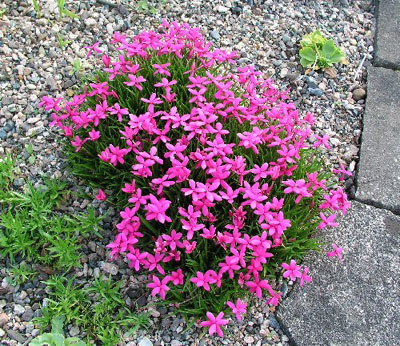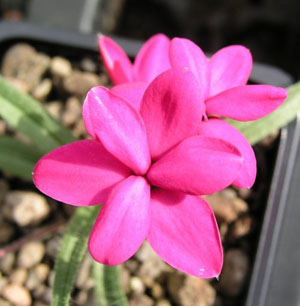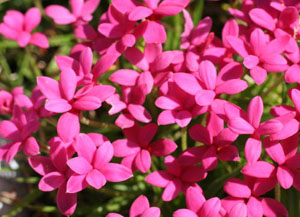|
Rhodohypoxis,
by Ian W Scroggy |
|
|
 |
|
Rhodohypoxis
EA Bowles |
|
Rhodohypoxis
(from the family Hypoxidaceae) originated in South Africa,
mostly where there are high summer rainfall and dry winters near
the Cape and Natal. In
their natural habitat they can be found on open grassy slopes in
areas of high altitude. They are technically not
"bulbs" but a type of corm like small tubers.
Each of these tiny tubers sends out lush green strap like
foliage in early Spring. The
leaves are slightly hairy - this helps the plants from drying
out in their natural habitat; the tiny hairs trap rain droplets
and channel the rain down to the centre of the corms.
From April to August you will get a succession of tiny
star like flowers ranging in colours of pink and white to dark
reds. Rhodohypoxis
only grows to 5cm in height on average although there are
exceptions. Rhodohypoxis deflexa, the smallest Rhodohypoxis only
reaches 2cm or less depending on position in your garden and
Rhodohypoxis 'Tetra White', sometimes called 'Helen', reaches
10cm. |
| Cultivation
;
Rhodohypoxis
prefer to be kept moist - do not overwater as this will only
rot the small thick tuberous roots.
Start watering from beginning of April right through to
two weeks after the leaves have gone yellow, usually in
September - this is vital to help build up the reserves in the
corm for the winter period.
If growing Rhodohypoxis in containers then it is easy
to lift your pots inside to a cold glasshouse and let the
corms dry out. The ideal time for repotting your corms is
January. Rhodohypoxis
like to grow in clumps; they will not do well if planted
singly so when dividing your clumps make sure you plant at
least three corms tight together.
|
 |
|
Rhodohypoxis
baurii |
|
|
|
 |
|
Rhodohypoxis
deflexa |
|
Potting
Mix:
I use a peat based compost as Rhodohypoxis prefer to
grow in slightly acidic conditions about ph 5.5 to 6, so
do not add Calcium Carbonate (lime) to your mix but do
add dolomite lime (magnesium lime). This is essential
for good root development - if there is not enough
magnesium in your mix you will get nutrient lock up, in
other words major nutrients like Potash and Potassium
will remain insoluble in the compost and your plant will
not be able to get the required nutrients in the correct
balance.
So
to 40 litres of sphagnum moss peat add 20 litres of
horticultural grit - make sure it is lime free grit
about 4mm in size. Then add 90grams of Dolomite lime and
120grams to 130grams of Osmocote (slow release
fertiliser). |
|
I
plant the corms in 7cm square pots at twice the depth of the
tuber and only lightly cover the corm with the potting mix, then
top dress the pot with grit in larger containers. You might want
to add a wire mesh above the tubers, this is to help prevent
mice from getting at the corms over the winter months.
I then place the pots in trays on a bench which is south
facing but I give shade from the East. The reason for this shade is to help prevent the pots from
warming up too quick in the spring mornings as this would only
force the corms on too quick and then they would get checked by
a late frost. The
other reason for the shade from the East is to keep the intense
colour of the flowers - deep reds require 40% shade to maintain
their true colour, full south facing sun will bleach the colour
of the flowers. Pink
and white forms are ok in full sun.
During active growth make sure to keep the plants well watered,
although this is not a problem in Ireland with all the rain we
get, and rain water is by far the best for Rhodohypoxis as they
like acidic conditions. I
only water late in the evenings during the summer months as
water sitting on the small flowers will act as small magnifying
glasses and in strong sun will burn the delicate flower petals.
Rhodohypoxis are much hardier than the gardening books
would make you believe, they will survive in the ground down to
-5 degree Celsius provided they have a very free draining
soil and are shaded from early morning sun. To do this all
you need is a well positioned small rock on the east side of the
plant.
Rhodohypoxis
are very floriferous, repeat flowering from April/May to August.
It is a good idea to remove dead flowers with their stems, as
the dead flowers tend to sit over the new flower buds trying to
push their way up through the foliage, and if these dead flowers
and stem are wet for prolonged periods this will rot the young
buds below them. When
planting Rhodohypoxis in the ground use the same potting mix as
mentioned above but this time use a larger grit onto gravel size
to mulch the top of the soil; about a 10mm gravel is ideal and
preferably a dark coloured gravel is best to show off the
flowers to their best potential. |
In
recent years nurserymen are trying to breed double flowers and
they have succeeded. 'Lilly Jean' as in the photograph is a
very good example of a clear pink double; these are best grown
in containers and protected from excess rain to maintain the
flowers for a longer period.
There are other doubles coming onto the market but most
are short lived. So far 'Lilly Jean' has done well, I have had
it for four years now and surviving well.
It
is hard to get another alpine plant that will bloom for such a
long time and consistently put on a "good show" -
they are a real show stopper. Rhodohypoxis 'E.A. Bowles' is a very good example, the pink
flowers form a lovely tight clump as in the top photograph.
Ian
W Scroggy |
 |
|
Rhodohypoxis
'Lilly Jean' |
|
|
